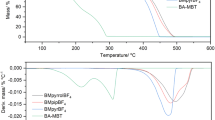Abstract
The effect of conductive carbon black (CCB) on the physico-mechanical, thermal, and electrical properties have been investigated by various characterization techniques. Physico-mechanical properties of the vulcanizates were studied with variation of filler loading, which revealed that the tensile strength increased up to 20 phr (parts per hundred rubber) CCB loading, whereas at higher filler loading it decreased marginally. Furthermore, tensile modulus, tear strength, and hardness gradually increased with increase in filler loading. The compression set and abrasion loss decreased with increasing CCB loading. The bound rubber content (Bdr) of unvulcanized rubber was found to increase significantly with increasing CCB content. The crosslink density increased, whereas the swelling decreased with CCB loading. The thermal stability of the vulcanizates evaluated by thermogravimetric analysis (TGA) showed a minor increment with increase in CCB content. It is observed from the dynamic mechanical thermal analysis (DMTA) that the storage modulus (E′), loss modulus (E″), and glass transition temperature (T g) of ethylene acrylic elastomer (AEM) matrix increased by incorporation of CCB. The dielectric relaxation characteristics of AEM vulcanizates such as dielectric permittivity (ε′), electrical conductivity (σ ac), and electric moduli (M′ and M″) have been studied as a function of frequency (101 to 106 Hz) at different filler loading. The variation of ε′ with frequency and filler loading was explained based on the interfacial polarization of the fillers within a heterogeneous system. The ε′ increased with increasing the CCB loading and it decreased with applied frequency. The frequency dependency of σ ac was investigated using conduction path theory and percolation threshold limit. The σ ac increased with increase in both CCB concentration and applied frequency. The M′ increased with applied frequency, however, it decreased above 30 phr filler. The M″ peak shifted towards higher frequency region and above 20 phr filler loading the peaks were not observed within the tested frequency region. The electromagnetic interference shielding effectiveness (EMISE) was studied in the X-band frequency region (8–12 GHz), which significantly improved with increase in CCB loading.











Similar content being viewed by others
References
Bokobza L (2007) Polymer 48:4907
Sau KP, Chaki TK, Khastgir D (1999) J Appl Polym Sci 71:887
Sridhar V, Choudhary RNP, Tripathy DK (2006) J Appl Polym Sci 102:1809
Mahapatra SP, Sridhar V, Chaudhary RNP, Tripathy DK (2007) Polym Eng Sci 47:984
Nanda M, Tripathy DK (2008) Express Polym Lett 2:855
Rahaman M, Chaki TK, Khastgir D (2011) J Mater Sci 46:3989. doi:10.1007/s10853-011-5326-x
Das NC, Chaki TK, Khastgir D (2002) Carbon 40:807
Mahapatra SP, Sridhar V, Chaudhary RNP, Tripathy DK (2007) Polym Compos 28:657
Tanrattanakul V, Bunchuay A (2007) J Appl Polym Sci 105:2036
Li ZH, Zhang J, Chen SJ (2008) Express Polym Lett 2:695
Wu Y-T, Stewart MA (2010) Ethylene acrylic elastomers. Encyclopedia of polymer science and technology. Interscience Wiley, New York
Karasek L, Sumita M (1996) J Mater Sci 31:281. doi: 10.1007/BF01139141
Flory PJ, Rehner J (1943) J Chem Phys 11:512
Huggins ML (1941) J Chem Phys 9:40
Flory PJ (1941) J Chem Phys 9:660
Kraus G (1963) J Appl Polym Sci 7:861
Sridhar V, Gupta BR, Tripathy DK (2006) J Appl Polym Sci 10:715
Roychoudhury A, De PP, Dutta NK, Choudhury N, Roychoydhury N, Haidar B, Vidal A (1993) Rubber Chem Technol 66:230
Wolff S, Wang MJ (1992) Rubber Chem Technol 65:329
Banik I, Bhowmick AK (2000) J Appl Polym Sci 76:2061
Choi SS, Nah C, Jo BW (2003) Polym Int 52:1382
Fukumori K, Kurauchi T, Kamigato O (1990) Polymer 31:713
Kader MA, Bhowmick AK (2003) J Appl Polym Sci 89:1442
Zhang J, Feng S, Ma Q (2003) J Appl Polym Sci 89:1548
López-Manchado MA, Biagiotti J, Valentini L, Kenny JM (2004) J Appl Polym Sci 92:3394
Psarras C, Manolakaki E, Tsangaris GM (2002) Composites 33:375
Ku CC, Liepins R (1987) Chemical principles. Hanser Publishers, Munich
Yuan Q, Wu D (2010) J Appl Polym Sci 115:3527
Li J, Kim J-K (2007) Compos Sci Technol 67:2114
Jäger K-M, McQueen DH, Tchmutin IA, Ryvkina NG, Klüppel M (2001) J Phys 34:2699
Datta S, De SK, Kontos EG, Wefer JM, Wagner P, Vidal A (1996) Polymer 37:3431
Patra A, Bisoyi DK (2010) J Mater Sci 45:5742. doi: 10.1007/s10853-010-4644-8
Xi Y, Bin Y, Chiang CK, Matsuo M (2007) Carbon 45:1302
Lvovich VF, Smiechowski MF (2005) J Electroanal Chem 577:67
Colarnerr NF, Saha TN (1992) IEEE Trans Instrum 41:291
Das NC, Khastgir D, Chaki TK, Chakraborty A (2000) Composites 31:1069
Ye L, Zhang Y, Wang Z (2007) J Appl Polym Sci 105:3851
Acknowledgement
The authors would like to gratefully acknowledge the financial assistance supported by the Board of Research in Nuclear Sciences (BRNS), India to carry out the research work. Contract grant sponsor: Board of Research in Nuclear Sciences (BRNS), Department of Atomic Energy (DAE), Mumbai, India; contract grant number: 2008/35/8/BRNS/3096 dated 23/03/2009
Author information
Authors and Affiliations
Corresponding author
Rights and permissions
About this article
Cite this article
Sahoo, B.P., Naskar, K. & Tripathy, D.K. Conductive carbon black-filled ethylene acrylic elastomer vulcanizates: physico-mechanical, thermal, and electrical properties. J Mater Sci 47, 2421–2433 (2012). https://doi.org/10.1007/s10853-011-6065-8
Received:
Accepted:
Published:
Issue Date:
DOI: https://doi.org/10.1007/s10853-011-6065-8




